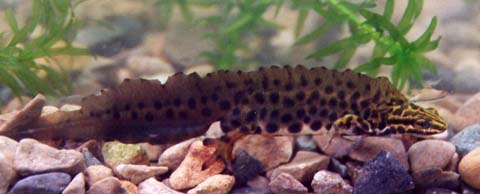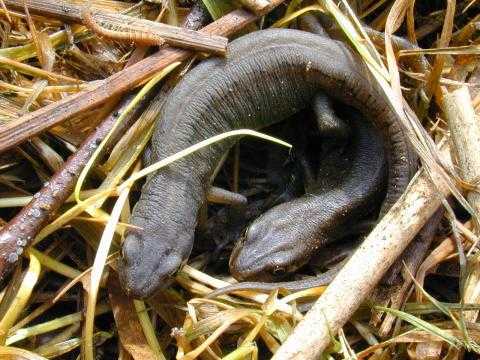

Male T. vulgaris

Two terrestrial-phase female T. vulgaris


Mating behaviour: male shown in black, female in white. From Arntzen & Sparreboom (1989).
DESCRIPTION
The smooth newt varies greatly in appearance over its range. The maximum length attained is around 10cm., although some individuals may be much smaller. The ground colour is olive-grey in both sexes. The belly is white or grey, with a central flash of red or orange. The belly is spotted, as is the throat. Males usually have more numerous and larger spots on their flanks than females, and some form of crest is present on breeding males, as is partial webbing on the hind feet, and a blue flash along the lower edge of the tail. The appearance of breeding males varies widely throughout the smooth newt's range, although females are relatively similar.
SUBSPECIES
T. v. vulgaris
In this subspecies, which occurs over most of northern Europe,
the breeding male has a high, wavy-edged crest. There is no tail
filament, and no dorsolateral ridges.
T. v. ampelensis
This subspecies occurs only in northern Rumania.
T. v. graecus
This subspecies is found in Greece and Bulgaria. Breeding males
exhibit relatively straight crests. There is also webbing on the
hind feet, and tail filaments, much like the palmate newt (which
does not occur in this area).
T. v. kosswigi
T. v. kosswigi occurs in northern Turkey, along the south
coast of the Black Sea. Like T. v. graecus, this
subspecies exhibits a straight crest, foot webs, and a tail
filament. In addition, it also has strong dorsolateral ridges,
also like the palmate newt.
T. v. lantzi
This subspecies occurs along the eastern edge of the Black Sea.
This is another subspecies having a tail filament, and well
developed foot webbing. However, this subspecies has a rather
denticulate (toothed) crest, like that of T. v. vulgaris
T. v. meridionalis
This Italian and Slovenian subspecies is another that has a tail
filament, pronounced webbing on the hind feet, and a straight
crest. The crest in this form is also rather low.
T. v. schmidtlerorum
This is a dwarf subspecies, growing to perhaps 6 cm, and occuring
in north-western Turkey. The foot webbing is very rudimentary,
and there is no tail filament. The crest is denticulated, even
spiky.
REFERENCES
Arntzen, J. W. & Sparreboom, M., 1989. A phylogeny for the Old World newts, genus Triturus: biochemical and behavioural data. Journal of Zoology 219: 645-664. [ABSTRACT]
Raxworthy, C. J., 1988. A description and study of a new dwarf species of smooth newt, Triturus vulgaris, from western Anatolia, Turkey. Journal of Zoology,215: 753-763 [ABSTRACT]
